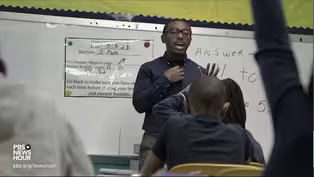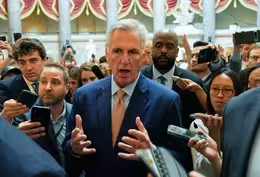
How the U.S. national debt reached $31.4 trillion
Clip: 5/23/2023 | 5m 43sVideo has Closed Captions
How the U.S. national debt reached $31.4 trillion
If you stacked up the full debt of the United States in hundred dollar bills, you could make not one, not two, but 13 piles of cash as tall as the Washington Monument. Lisa Desjardins takes a look at what the nation owes and has the latest on the debt ceiling negotiations on Capitol Hill.
Problems playing video? | Closed Captioning Feedback
Problems playing video? | Closed Captioning Feedback
Major corporate funding for the PBS News Hour is provided by BDO, BNSF, Consumer Cellular, American Cruise Lines, and Raymond James. Funding for the PBS NewsHour Weekend is provided by...

How the U.S. national debt reached $31.4 trillion
Clip: 5/23/2023 | 5m 43sVideo has Closed Captions
If you stacked up the full debt of the United States in hundred dollar bills, you could make not one, not two, but 13 piles of cash as tall as the Washington Monument. Lisa Desjardins takes a look at what the nation owes and has the latest on the debt ceiling negotiations on Capitol Hill.
Problems playing video? | Closed Captioning Feedback
How to Watch PBS News Hour
PBS News Hour is available to stream on pbs.org and the free PBS App, available on iPhone, Apple TV, Android TV, Android smartphones, Amazon Fire TV, Amazon Fire Tablet, Roku, Samsung Smart TV, and Vizio.
Providing Support for PBS.org
Learn Moreabout PBS online sponsorshipWILLIAM BRANGHAM: If you stacked up the full debt of the United States in $100 bills, you could make not one, not two, but 13 piles of cash as tall as the Washington Monument.
Lisa Desjardins takes a step back from the debt ceiling negotiations on Capitol Hill to account for what the nation owes.
LISA DESJARDINS: OK, the national debt, all of the money the U.S. government owes, is currently $31.4 trillion.
But what does that mean?
For one, that's decades' worth of government spending, things like Medicaid and other health care, the U.S. military, food stamps, and other benefits, fixing roads, Head Start and schools, the environment, national parks, and 1,000 other areas.
It's simple.
For years, what the U.S. government spent on those things was far greater than the amount of money it had brought in to pay for them.
That stacked up to that $31.4 trillion in debt we have now.
That's an enormous, almost nonsensical number.
So let's put it a different way.
If all Americans pitched in, it would take $94,000 from each one of us, every man, woman and child, to pay off the national debt.
The U.S. national debt, in dollars, is by far the largest in the world.
But we also have the largest economy in the world.
And that is how most experts approach this.
Think of it this way.
The national debt is a weight, sometimes a heavy weight, like a barbell at a gym.
But what matters is not just the size of the debt, but the size of the economy, or person, trying to handle that debt.
So, how big is our debt compared to the economy trying to hold it up?
Back in the year 2000, it was a relatively easy.
The debt equaled 36 percent of the combined earnings, goods, and everything the U.S. economy produced that year.
But it shot up, and now the U.S. is shouldering a national debt that is 98 percent of what we will produce this year.
And, much worse, if nothing changes, in 30 years, the debt is forecasted to soar to be nearly twice as large as everything the economy produces, a potentially overwhelming weight for the U.S. economy.
MICHAEL PETERSON, CEO, The Peter G. Peterson Foundation: As the debt keeps creeping up, we just are placing a greater and greater burden on the next generation.
LISA DESJARDINS: Michael Peterson is CEO of The Peterson Foundation, a nonprofit group focused on the U.S. budget long-term.
And he is particularly worried about the cost of the debt.
MICHAEL PETERSON: The interest cost is really what is the cost of the debt.
If you think over a long period of time, by about 2050, approximately 50 percent of federal revenues will go towards interest only.
LISA DESJARDINS: That means, by 2053, when little kids today are in their 30s, the interest costs on the national debt will be the largest expenditure the federal government has, and 50 percent, half, of the taxes that these guys pay will go to those interest costs.
That will constrict funding for everything, including what we mentioned earlier, health care, the military, food stamps, education and the environment.
Even Social Security benefits would be significantly cut.
There is still time to change course and multiple ways to address the debt.
But the longer lawmakers wait to tackle it, the deeper and more painful future cuts and the future burden will be.
For the "PBS NewsHour," I'm Lisa Desjardins.
WILLIAM BRANGHAM: In just the time it took Lisa to tell that story, the U.S. slipped nearly $10 million deeper into debt.
And each passing second brings the country closer to a first-ever default.
Lisa has spent the day chasing down lawmakers, and she now joins us to bring us up to speed.
Lisa, a terrific report on the debt there, but back to these talks on Capitol Hill.
We are right at the precipice here.
What is the current status of negotiations.
LISA DESJARDINS: We're getting close.
As you said, I was on the Hill with our producer Kyle Midura.
This is where we are.
Talks are at a standstill at this moment.
In fact, Speaker McCarthy earlier today said talks had broken down.
Really, there -- there is some agreement over many areas, but they are not making any distance over two big areas.
That is work requirements, which Republicans want to add more of for some benefits.
And then the other one, here you see Republicans, the White House lawmakers coming in for the morning meeting.
Republicans also say they are just -- there's Speaker McCarthy -- simply too far apart when it comes to spending and funding.
One dynamic we have seen today, William, is Speaker McCarthy again and again coming and talking to reporters.
Republicans feel like they're winning the sort of public argument here.
We're seeing Democrats just starting to speak to us more.
But I think, right now, the House is expected to recess on Thursday with no deal.
And I think, this weekend, we could still be talking about this.
WILLIAM BRANGHAM: Well, you, I know, in addition to all your other reporting, have some reporting about what the Treasury Department might be doing in case we get to this dreaded moment.
What is that?
LISA DESJARDINS: Sources familiar have confirmed that the U.S. Treasury has sent out notices to government agencies asking them to hold off on any payments that don't have specific due dates right now.
It's something that maybe pro forma or just kind of happenstance.
They were sending out these payments, but they can wait.
They have a deadline that they don't have to meet.
They're saying hold back on that, the U.S. Treasury essentially trying to hold on to some kind of cushion of cash, because it is getting concerned that we're close to the deadline, and it may come down to a few hundred million dollars, which is usually not a lot for the U.S. Treasury, but could make a big difference in these negotiations.
WILLIAM BRANGHAM: Lisa Desjardins, as always, thank you so much.
LISA DESJARDINS: You're welcome.
Artist uses architecture of Guggenheim in new installation
Video has Closed Captions
Clip: 5/23/2023 | 5m 49s | Artist Sarah Sze uses architecture of Guggenheim Museum as part of her new installation (5m 49s)
Black teachers counteract dropout rate among Black students
Video has Closed Captions
Clip: 5/23/2023 | 6m 40s | Organization mentors Black teachers to counteract dropout rate among Black students (6m 40s)
Dodgers re-invite drag group to Pride Night after backlash
Video has Closed Captions
Clip: 5/23/2023 | 7m 16s | Los Angeles Dodgers re-invite satirical drag group to Pride Night after backlash (7m 16s)
The human toll of the battle for Bakhmut in eastern Ukraine
Video has Closed Captions
Clip: 5/23/2023 | 3m 46s | The human toll of the battle for Bakhmut in eastern Ukraine (3m 46s)
The potential impacts of the U.S. defaulting on its debt
Video has Closed Captions
Clip: 5/23/2023 | 6m 8s | Economist Mark Zandi on the potential impacts of the U.S. defaulting on its debt (6m 8s)
Tenuous ceasefire in Sudan offers some needed relief
Video has Closed Captions
Clip: 5/23/2023 | 5m 46s | Tenuous ceasefire in Sudan offers some needed relief after weeks of brutal fighting (5m 46s)
Uvalde still seeking accountability a year after shooting
Video has Closed Captions
Clip: 5/23/2023 | 5m 28s | Uvalde community still seeking accountability a year after elementary school shooting (5m 28s)
Providing Support for PBS.org
Learn Moreabout PBS online sponsorship
- News and Public Affairs

FRONTLINE is investigative journalism that questions, explains and changes our world.

- News and Public Affairs

Amanpour and Company features conversations with leaders and decision makers.












Support for PBS provided by:
Major corporate funding for the PBS News Hour is provided by BDO, BNSF, Consumer Cellular, American Cruise Lines, and Raymond James. Funding for the PBS NewsHour Weekend is provided by...






